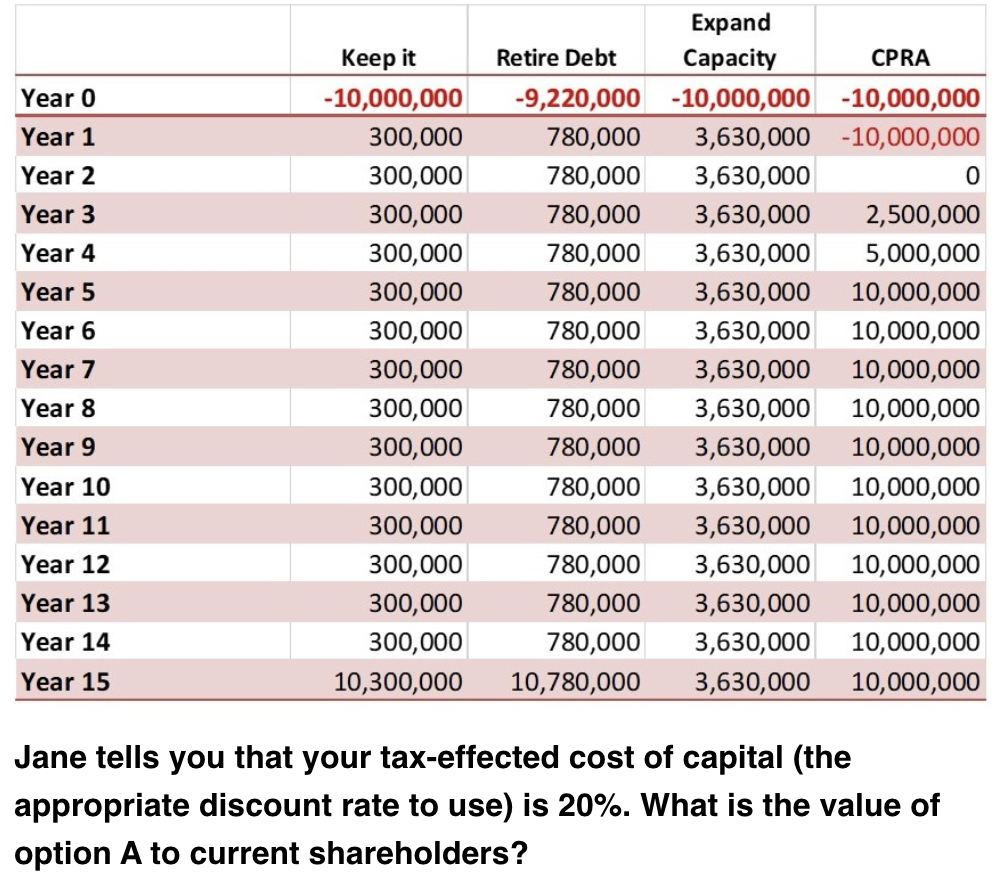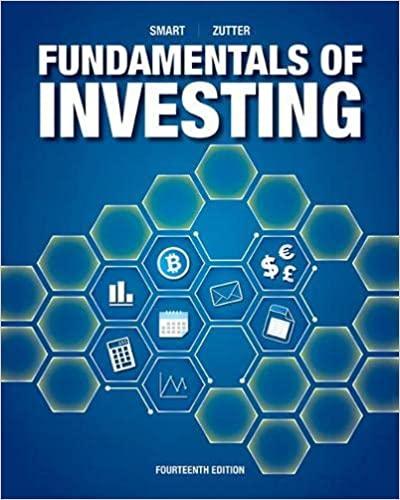Question
Your company has $10,000,000 in excess cash more than you need to provide a cushion on your balance sheet to protect against risk. Jane, your
Your company has $10,000,000 in excess cash more than you need to provide a cushion on your balance sheet to protect against risk. Jane, your crack financial analyst, has prepared a set of options for you to consider. They are:
A) Keep the $10,000,000 on the balance sheet and earn a 3.0% after-tax return from the bank for the next 15 years. B) You have $10m in non-amortizing bonds outstanding, with 15 years left, 12% annual interest coupon, and the total principal repayment due at the end of the term. Your bondholders have offered to sell the bond back to you at par value. Assume a tax rate of 35%. C) Expand your plant for a cost of 165,000 units per shift for a total capital cost of $10,000,000. You can expect an $11 after-tax contribution margin per unit and that you can run this new portion of the plant for 2 shifts for the next 15 years, at which point the equipment will need to be scrapped. D) Spend the $10,000,000 this year and another $10,000,000 next year on inventing the CPRA product. Jane says you will yield zero incremental after-tax contribution margin the following year, but $2.5m the year after that, $5m the year after that, and $10m per year thereafter until year 15, at which point Jane says its reasonable to assume that the CPRA product will have been supplanted by other technologies.
Jane has prepared a worksheet where she has laid out for you the cash flows associated with these decisions from the shareholders perspective. Use this table of cash flows for the next 6 questions.

After this:
C) Expand your plant for a cost of 165,000 units per shift for a total capital cost of $10,000,000. You can expect an $11 after-tax contribution margin per unit and that you can run this new portion of the plant for 2 shifts for the next 15 years, at which point the equipment will need to be scrapped.
Continue to assume that the cost of capital is 20%, what is the value of option C to current shareholders?
D) Spend the $10,000,000 this year and another $10,000,000 next year on inventing the CPRA product. Jane says you will yield zero incremental after-tax contribution margin the following year, but $2.5m the year after that, $5m the year after that, and $10m per year thereafter until year 15, at which point Jane says its reasonable to assume that the CPRA product will have been supplanted by other technologies.
At a discount rate of 20%, what is the value of option D to current shareholders?
What if your cost of capital was 12% instead of 20%? Which option (A, B, C, or D) creates the most value to current shareholders?
Year 0 Year 1 Year 2 Year 3 Year 4 Year 5 Year 6 Year 7 Keep it -10,000,000 300,000 300,000 300,000 300,000 300,000 300,000 300,000 300,000 300,000 300,000 300,000 300,000 300,000 300,000 10,300,000 Expand Retire Debt Capacity CPRA -9,220,000 -10,000,000 -10,000,000 780,000 3,630,000 -10,000,000 780,000 3,630,000 0 780,000 3,630,000 2,500,000 780,000 3,630,000 5,000,000 780,000 3,630,000 10,000,000 780,000 3,630,000 10,000,000 780,000 3,630,000 10,000,000 780,000 3,630,000 10,000,000 780,000 3,630,000 10,000,000 780,000 3,630,000 10,000,000 780,000 3,630,000 10,000,000 780,000 3,630,000 10,000,000 780,000 3,630,000 10,000,000 780,000 3,630,000 10,000,000 10,780,000 3,630,000 10,000,000 Year 8 Year 9 Year 10 Year 11 Year 12 Year 13 Year 14 Year 15 Jane tells you that your tax-effected cost of capital (the appropriate discount rate to use) is 20%. What is the value of option A to current shareholders
Step by Step Solution
There are 3 Steps involved in it
Step: 1

Get Instant Access to Expert-Tailored Solutions
See step-by-step solutions with expert insights and AI powered tools for academic success
Step: 2

Step: 3

Ace Your Homework with AI
Get the answers you need in no time with our AI-driven, step-by-step assistance
Get Started


